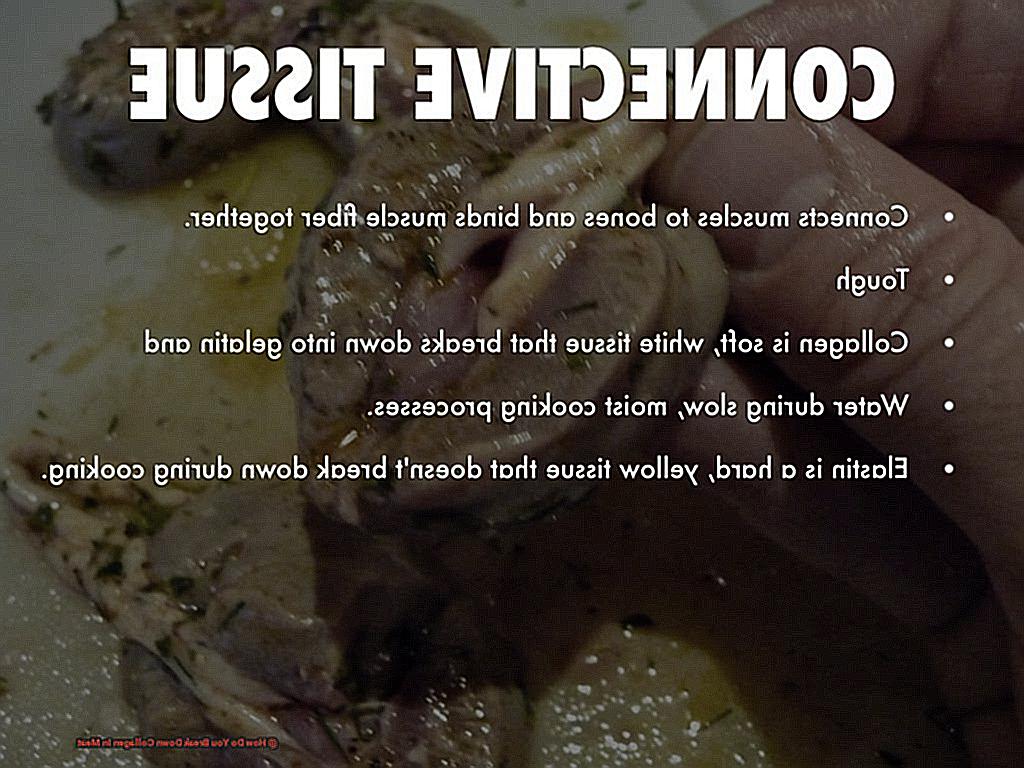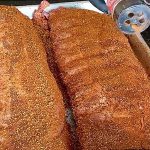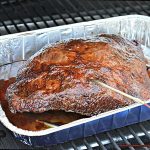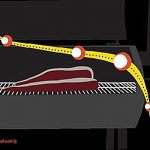Do you ever find yourself gnawing on a tough, chewy piece of meat and wishing it could be more tender? Well, the key to achieving that melt-in-your-mouth texture lies in breaking down collagen. This protein is responsible for forming the connective tissue in meat, but it can also make it difficult to enjoy. Fear not, there are several ways to break down collagen and transform your meat into a delectable dish.
One method is to cook low and slow. Collagen begins to break down at temperatures above 160°F, but it takes time for this process to occur. Cooking meat at low temperatures for an extended period, such as through slow-cooking or braising, allows the collagen to break down and results in juicy and tender meat.
Another option is using acidic ingredients like vinegar or citrus juice in marinades. These ingredients help denature the protein fibers in collagen, breaking them down over time. However, be careful not to marinate your meat for too long as it can become mushy and lose its texture.
Lastly, mechanical tenderizing can also break down collagen fibers. Using a meat mallet or tenderizing tool physically breaks apart the connective tissue. But use caution when using this method because over-tenderizing can lead to unappetizingly soft meat.
By utilizing one or a combination of these methods, you’ll be able to elevate your meat dishes and achieve perfect tenderness every time. Say goodbye to tough steaks and hello to mouth-watering meals.
Contents
How Heat Breaks Down Collagen
The answer lies in the breakdown of collagen, a protein found in the connective tissues of meat. While there are several ways to break down collagen in meat, heat is one of the most common and effective methods.
When heat is applied to meat, the collagen fibers begin to unwind and separate from each other in a process called denaturation. This causes the collagen to break down into gelatin, which is responsible for the tender texture of cooked meat. However, it’s important to note that overcooking meat can cause the collagen to break down too much, resulting in a mushy texture. To avoid this, it’s crucial to monitor the cooking process carefully and remove the meat from the heat source once it reaches the desired level of tenderness.
Slow cooking methods like braising and stewing are ideal for tougher cuts of meat because they allow the collagen to break down slowly over time. This process can take several hours depending on the cut of meat and the cooking method used. Patience is key when it comes to breaking down collagen with heat.
In addition to heat, there are other factors that can affect how collagen breaks down in meat. Acidic ingredients like citrus juice or vinegar can help to break down collagen fibers, as well as enzymes found in certain fruits like papaya and pineapple. Mechanical means such as pounding or tenderizing with a meat mallet can also break up the collagen fibers and make the meat more tender.
To summarize, here are some key takeaways about how heat breaks down collagen in meat:
- Heat causes collagen fibers to unwind and separate from each other
- This process is called denaturation and results in the formation of gelatin
- Slow cooking methods like braising and stewing are ideal for breaking down collagen over time
- Overcooking meat can cause the collagen to break down too much, resulting in a mushy texture
- Acidic ingredients and enzymes found in certain fruits can also help to break down collagen
- Mechanical means like pounding or tenderizing can make meat more tender
Using Acids to Break Down Collagen
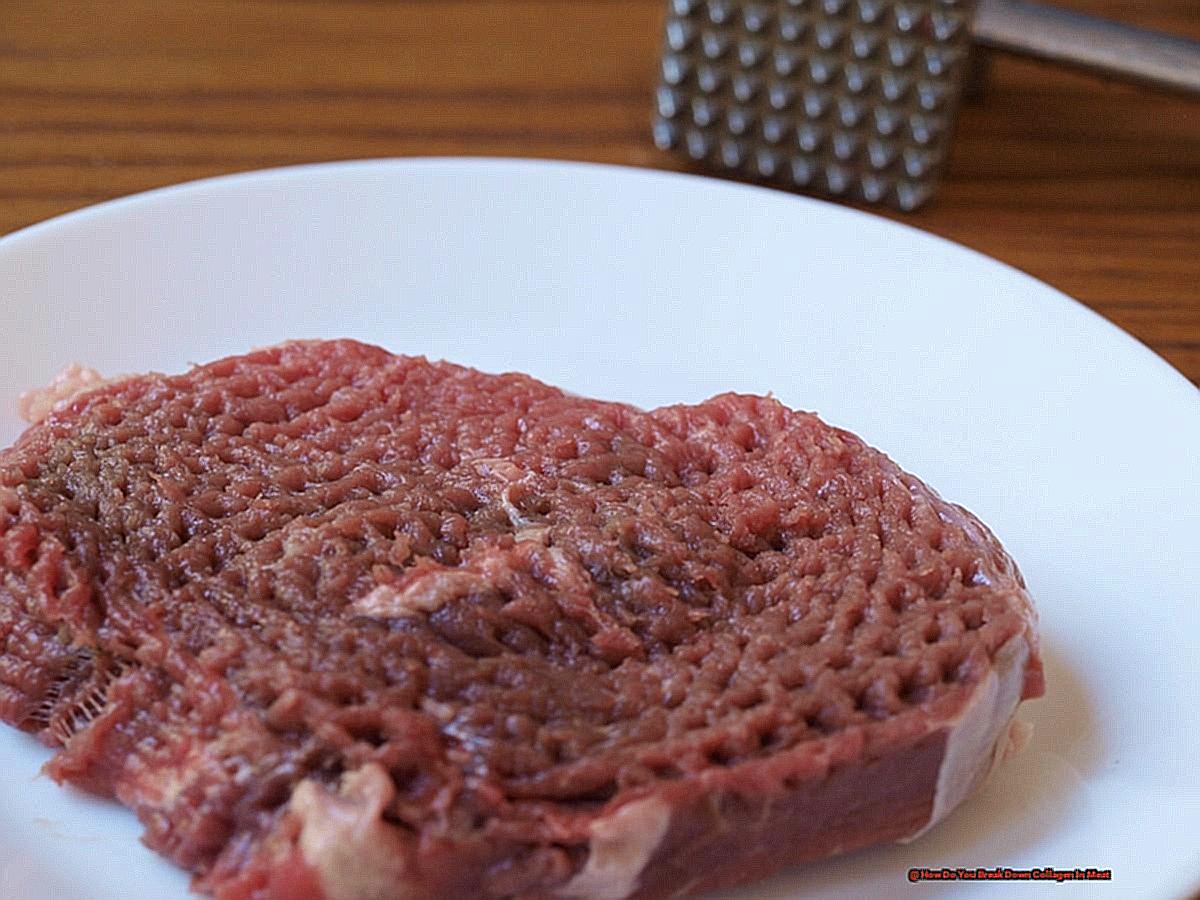
Vinegar is a pantry staple and a popular choice for breaking down collagen in meat. Its acetic acid works wonders in tenderizing the meat by breaking down the tough collagen fibers. Marinating the meat in vinegar for several hours before cooking is an easy way to incorporate this method into your cooking routine. The longer you marinate, the more tender your meat will become.
Citrus juice is another versatile acid that can be used to break down collagen in meat. The citric acid in fresh lemon or lime juice helps to tenderize the meat by breaking down the collagen fibers. Simply squeeze the juice over the meat before cooking to experience the benefits of this method. You’ll love how it adds a bright, zesty flavor to your dish.
Wine is another acid that can be used to break down collagen in meat and infuse it with rich flavor. Red wine contains tannins that work to break down the collagen fibers and tenderize the meat. Marinating the meat in red wine for several hours before cooking can result in a deliciously tender and flavorful dish.
It’s important to note that while acids can help tenderize meat, they can also affect its flavor. Carefully select an acid that complements the flavors of your dish. Over-marinating can also lead to a mushy texture, so use caution and follow recipes carefully.
Enzymes for Breaking Down Collagen
Collagen is a structural protein found in connective tissues like tendons and ligaments. It provides strength and support to these tissues but can make meat difficult to chew. Luckily, there are specific enzymes that can help tenderize meat by breaking down collagen.
Proteases are a group of enzymes found in digestive juices like stomach acid and pancreatic juice. They work by breaking down proteins into smaller peptides and amino acids. By breaking the peptide bonds that hold protein molecules together, proteases make the meat more tender.
Bromelain, an enzyme found in pineapples, is another option for breaking down collagen. It works by breaking down the cross-linking bonds between collagen molecules. This makes the meat more tender and easier to chew.
Papain, an enzyme found in papayas, also helps break down collagen in meat. Like bromelain, it targets the cross-linking bonds between collagen molecules. Papain is often used as a meat tenderizer and can be found in some commercial meat tenderizers.
It’s crucial to use these enzymes correctly to avoid over-tenderizing the meat, which can result in a mushy texture. Additionally, not all meats require enzymatic tenderizing. Tender cuts like beef tenderloin or pork loin are naturally soft and don’t need additional methods.
Papain and Bromelain for Tenderizing Meat
Papain and bromelain, two natural enzymes derived from papaya fruit and pineapples, respectively, can work wonders in tenderizing meat. These powerful enzymes break down the collagen fibers in meat, which are responsible for making it tough and chewy, into smaller peptides that result in a more tender and flavorful final product.
While these enzymes are effective in tenderizing meat, it’s crucial to use them in moderation. Overuse can lead to mushy meat lacking texture, ruining your meal. Additionally, it’s important to note that papain and bromelain work best on certain types of meat, such as beef and pork, and may not be as effective on others.
To apply papain or bromelain to tenderize meat, there are two primary methods: surface application and marinating. For surface application, sprinkle a small amount of the enzyme powder onto the surface of the meat and let it sit for 30 minutes to an hour before cooking. For marinating, mix the enzyme powder with a liquid such as water or juice and let the meat soak for several hours before cooking.
It’s important to remember that some cuts of meat are naturally soft and don’t require tenderizing. Before applying any tenderizing methods, do some research on the cut you’re working with.
Mechanical Methods of Breaking Down Collagen
Mechanical methods of breaking down collagen can turn even the toughest cuts into succulent, juicy dishes that will leave your taste buds dancing.
One popular method is pounding. By grabbing a meat mallet or tenderizer and repeatedly striking your meat, you can break down the connective tissue and fibers, resulting in a more tender product. Pounding is especially effective for tougher cuts of meat, such as beef or pork.
Grinding is another fantastic option. Not only does it break down collagen, but it also helps distribute fat throughout the meat for added flavor. This method is commonly used when making ground beef or sausage.
Slicing against the grain is yet another technique that can be used for breaking down collagen. By cutting the meat against the grain, you’re able to break down the tough fibers and connective tissue, resulting in a more tender end product that’s easy to chew.
It’s important to note that these mechanical methods must be used with caution since over-tenderization can occur if not done correctly. Always follow proper cooking techniques to ensure that your meat is cooked to perfection.
Benefits of Breaking Down Collagen in Meat
Well, breaking down collagen in meat can solve this problem and elevate your cooking game. As an expert on the benefits of this process, let me tell you why it’s a game-changer for your dishes.
Collagen is a protein present in connective tissue, bones, and cartilage of animals. When meat is cooked, the collagen begins to break down and convert into gelatin. This process is where the magic happens.
Breaking down collagen makes tough cuts of meat more tender and flavorful. No more gnawing on a steak like a caveman – when collagen breaks down, it releases moisture and flavor into the meat, making it juicy and delicious. Additionally, it’s an excellent way to transform cheaper cuts of meat into desirable dishes.
Not only does breaking down collagen make meat more palatable, but it also makes it easier to digest. Gelatin (the end result of collagen breakdown) is easier on the stomach because it’s already partially broken down. Individuals with sensitive stomachs or digestive issues may find that they can tolerate gelatinous meats better than tough cuts.
Moreover, breaking down collagen in meat has health benefits too. Gelatin is rich in amino acids like glycine and proline, which have been linked to improved joint health, gut health, and skin health. It may even help reduce inflammation throughout the body.
There are various methods to break down collagen in meat, such as pounding, grinding, and slicing against the grain. However, it’s essential to use caution and follow proper cooking techniques to avoid over-tenderization.
Tips for Breaking Down Collagen in Meat
Breaking down collagen in meat is the key to achieving tender, juicy, and flavorful meats. Collagen is a protein that provides structure and support to connective tissues in meat, making it tough and challenging to cook. Here are five tips for breaking down collagen in meat.
Slow Cooking:
Slow cooking at low temperatures is one of the most effective ways to break down collagen in meat. This method allows the collagen to break down gradually, resulting in a tender and succulent texture. You can use methods such as braising, stewing or using a slow cooker for this. The low temperature and extended cooking time help to dissolve the collagen fibers, resulting in a melt-in-your-mouth experience.
Marinating:
Marinades can also help break down collagen in meat. Acidic ingredients such as vinegar, lemon juice, or wine can help to break down the tough fibers of the meat. Marinating the meat for longer periods allows the acid to penetrate deeper into the meat, resulting in a more tender and flavorful dish. Additionally, herbs and spices can add an extra depth of flavor to your dish.
Enzymatic Marinades:
Enzymatic marinades containing papaya or pineapple can also be effective in breaking down collagen. These enzymes work by breaking down the collagen into smaller pieces, making it easier to chew and digest. The enzymes in these fruits are natural tenderizers that help to reduce cooking time while enhancing flavor.
Tenderizers:
Meat tenderizers contain enzymes that break down collagen, making it easier to chew. However, it is important to use tenderizers sparingly as they can affect the flavor and texture of the meat. Tenderizers are ideal for tougher cuts of meat, but they should be applied according to instructions for best results.
Slicing:
Slicing against the grain can also help to break down collagen in meat. The grain refers to the direction of the muscle fibers in the meat. Slicing against the grain breaks up these fibers, making it easier to chew. It is essential to identify the grain before slicing the meat to achieve the desired texture.
Common Mistakes When Breaking Down Collagen
One of the keys to tender and juicy meat is breaking down collagen, a protein found in meat that contributes to its toughness. However, there are common mistakes people make when attempting to break down collagen in meat. Let’s explore these mistakes so you can avoid them and impress your guests with delicious meat.
First on our list of mistakes is not using the right cooking method. Collagen breaks down at around 160-180°F (71-82°C), making low and slow cooking methods like braising, stewing, and slow roasting ideal for breaking down collagen. On the other hand, high heat cooking methods like grilling and broiling won’t give enough time for the collagen to break down properly and can result in tough and chewy meat.
Another mistake is not allowing your meat to rest after cooking. Resting allows the juices to redistribute throughout the meat, resulting in a more tender and flavorful result. Cutting into your meat right after cooking can cause all of those precious juices to escape, leaving you with dry and tough meat.
Marinades are another area where people often make mistakes. While acidic marinades can help break down collagen, leaving your meat in an acidic marinade for too long can actually have the opposite effect. Over-marinating with acid can lead to over-acidification of the meat, resulting in tougher meat. So be careful not to leave your meat in an acidic marinade for too long.
Lastly, using the wrong cut of meat can make breaking down collagen difficult. Tougher cuts of meat like chuck roast, brisket, and short ribs have more collagen than tender cuts like filet mignon or ribeye. Using a tender cut for a low and slow cooking method won’t allow enough time for the collagen to break down properly. So, choose the right cut of meat for the cooking method you plan to use.
Conclusion
In conclusion, the secret to succulent and flavorful meat lies in breaking down collagen. This protein is responsible for providing structure and support to connective tissues in meat, which can make it tough and unpalatable. However, there are several effective methods for breaking down collagen, including low and slow cooking, acidic marinades, enzymatic marinades, mechanical tenderizing, and slicing against the grain.
It’s crucial to exercise caution when breaking down collagen since over-tenderization can ruin your dish if not done correctly. Additionally, selecting the right cooking method and cut of meat is essential for achieving optimal results. Resting your meat after cooking is also a must to allow juices to redistribute throughout the meat.
Breaking down collagen not only makes meat more tender but also easier to digest. Gelatin (the end product of collagen breakdown) is gentler on the stomach because it’s already partially broken down. Furthermore, breaking down collagen in meat has numerous health benefits. Gelatin is rich in amino acids such as glycine and proline that have been linked to improved joint health, gut health, and skin health.
By utilizing one or a combination of these methods for breaking down collagen in meat correctly, you’ll be able to take your dishes to the next level and achieve perfect tenderness every time.

